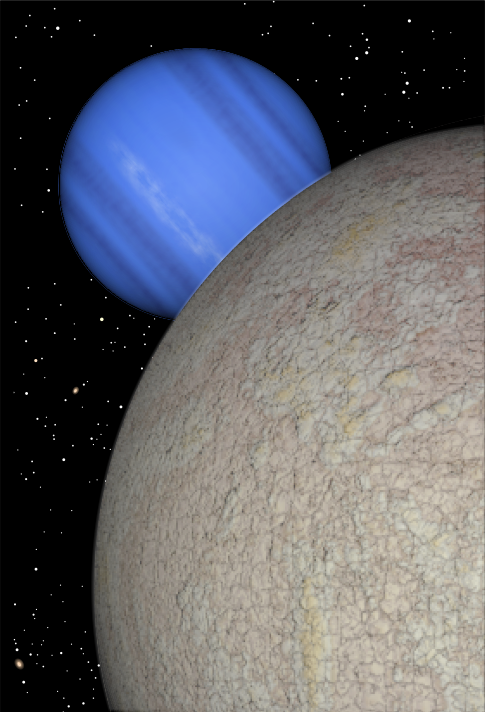|
Objects within the Neptune system are generally named for mythical entities relating to the sea, and Neptune's largest moon Triton is no exception; in Greek mythology Triton was the son of Poseidon (the Greek equivalent of Neptune) and a sea-god in his own right.
Origins and Orbit

Barely visible along the limb of Triton, especially against the blue disc of Neptune, a thin and hazy line can be seen. This is Triton's tenuous atmosphere, composed primarily of Nitrogen.
In terms of size and mass, Triton dominates the other moons of Neptune, and indeed its diameter of some 2,700 km makes it only marginally smaller than Earth's Moon. It orbits far from Neptune, farther out than any of its fellow major satellites apart from Nereid, whose eccentric orbit can carry it immensely far from Neptune (and there are also a group of tiny distant moons orbiting more distantly still). Triton is curious in that follows an orbital path opposite to the rotational direction of Neptune itself, or of any of its inner moons. This feature makes it unique among the Solar System's major satellites, and strongly suggests that it was not an original member of Neptune's system of moons. Rather, it seems to be an object from the Kuiper Belt that was captured by the gravity of Neptune.
The likelihood of Triton's origins in the Kuiper Belt is increased by comparison with Pluto, which orbits within the Belt, and with which Triton shares many characteristics. Triton is in fact slightly larger than Pluto, and if it had escaped capture by Neptune it would now be counted among the Solar System's dwarf planets. Instead the moon's orbit pursues a course around the ice giant Neptune, to which it has now become synchronised: like Earth's Moon, its pattern of rotation means that it always shows the same face to its primary planet.
Physical Structure
Physically, Triton has a rocky and metallic inner core surrounded by a crust of frozen water ice, with a surface layer of frozen nitrogen. It is one of the few bodies in the Solar System known to be geologically active, with a surface dotted with geysers and cryovolcanoes. These erupt nitrogen from the surface in plumes that can reach up to eight kilometres in height, with individual eruptions sometimes lasting for as a long as a year.
This regular emergence of subsurface material means that much of Triton's surface formed relatively recently, and hence shows comparatively little cratering. The moon does display four prominent walled plains, and following the oceanic naming conventions of the Neptunian system, each of the four is named for a mythical island: the Ruach, Ryugu, Sipapu and Tuonela Planitiae. Elsewhere the surface is marked by patterns of linear ridges and valleys, thought to be due to the moon undergoing periodic cycles of freezing and thawing.
|
|